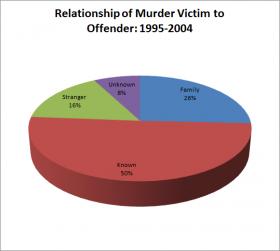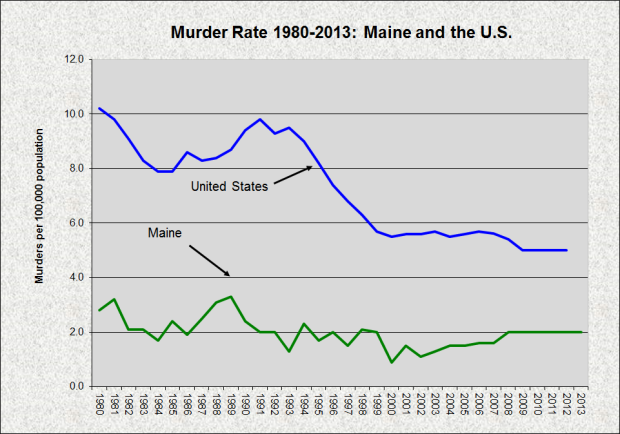| Rate/100000 | |||
| Year | Murders | Maine | U.S. |
| 1980 | 32 | 2.8 | 10.2 |
| 1981 | 36 | 3.2 | 9.8 |
| 1982 | 24 | 2.1 | 9.1 |
| 1983 | 24 | 2.1 | 8.3 |
| 1984 | 20 | 1.7 | 7.9 |
| 1985 | 28 | 2.4 | 7.9 |
| 1986 | 22 | 1.9 | 8.6 |
| 1987 | 30 | 2.5 | 8.3 |
| 1988 | 37 | 3.1 | 8.4 |
| 1989 | 40 | 3.3 | 8.7 |
| 1990 | 29 | 2.4 | 9.4 |
| 1991 | 24 | 2.0 | 9.8 |
| 1992 | 25 | 2.0 | 9.3 |
| 1993 | 16 | 1.3 | 9.5 |
| 1994 | 28 | 2.3 | 9.0 |
| 1995 | 21 | 1.7 | 8.2 |
| 1996 | 25 | 2.0 | 7.4 |
| 1997 | 19 | 1.5 | 6.8 |
| 1998 | 26 | 2.1 | 6.3 |
| 1999 | 25 | 2.0 | 5.7 |
| 2000 | 11 | 0.9 | 5.5 |
| 2001 | 19 | 1.5 | 5.6 |
| 2002 | 14 | 1.1 | 5.6 |
| 2003 | 17 | 1.4 | 5.7 |
| 2004 | 19 | 1.5 | 5.5 |
| 2005 | 19 | 1.5 | 5.6 |
| 2006 | 21 | 1.6 | 5.8 |
| 2007 | 21 | 1.6 | 5.7 |
| 2008 | 31 | 2.0 | 5.4 |
| 2009 | 26 | 2.0 | 5.0 |
| 2010 | 24 | 2.0 | 5.0 |
| 2011 | 25 | 2.0 | 5.0 |
| 2012 | 24 | 2.0 | 5.0 |
| 2013 | 24 | 2.0 | N/A |
Maine has a relatively low murder rate, consistent with its overall low crime rate. The 33 year average from 1980 through 2012 is fewer than 25 murders per year, ranging from a high of 40 in 1989 to a low in 2000 of 11. During the period, Maine’s rate averages 2.0 per 100,000 population, compared to the U.S. average of 7.2, nearly four times that of Maine. Guns are the weapons most used.
In the charts at left (click to enlarge), “Unknown” means the relationship was not determined. During the ten-year period 1995-2004 victims were most likely to be murdered by someone not a family member but known to them. The chances of being murdered by a stranger were less than on in six. In the 2005-2011 period the chances were only one in 20.
As is the case nationally, most murder victims knew their killers and, more often than not, they were family members or otherwise known to the victim. The basic change over the seventeen-year period is the decrease in “stranger” murders.
In any five-year average period, no more than 25% of murderers were strangers to the victim; however, an increase in “girlfriend/boyfriend” murders increased. (Pre-1995 data did not include the “girlfriend/boyfriend” category.) As Maine’s population has increased in recent years, no trend toward more “stranger” murders is apparent.
When particularly upsetting murders have gotten wide publicity, calls for re-instituting the death penalty arise. See the history of capital punishment in Maine.
——————————
The largest mass poisoning in U.S. history occurred in New Sweden on April 27, 2003. One person died, fifteen others became ill from arsenic placed in the coffee at the Gustaf Adolph Lutheran Church. As in so many other cases, a person known to the victims, a member of the church, was suspected of committing the act. Whether it was murder or accidental, a single perpetrator or more than one, remained unclear in the months that followed.
On May 2, 2003 Daniel Bondeson wrote the following suicide note (misspellings and underlines as they appear in the note according to the newspaper report):
I didn’t know it was arsenic. I thought it was something? I had no intent to hurt this way. Just to upset stomach, like the church goers did me. [Three first names are listed], and others. Put something oscar in on me (coffee). So the opporinity came up and I thought I would do it. I am not angry at the business of the church. I hate that this happened, but who wants to spend time in jail. Even if you can get away with this, life is still not the same. Considering what I did, this is the best conclusion. I didn’t intent to have this result. I acted alone, One dumb poor judgement ruins life, but I did wrong. Life started to be good.
Several days before the contents of the suicide note was released in April 2006, the Maine Attorney General’s Office announced that it had closed the case .
Additional resources
Crimes and Crime Rates by Type of Offense: 1980 to 2009. (Table 306) http://www.census.gov/compendia/statab/cats/law_enforcement_courts_prisons/crimes_and_crime_rates.html
De Wolfe, Elizabeth A. The Murder of Mary Bean and Other Stories Kent, Ohio. Kent State University Press. c2007.
Loughlin, Joseph K. Finding Amy: A True Story of Murder in Maine. Hanover: University Press of New England. c2006.
Maine Department of Public Safety. Crime in Maine. Augusta, ME. various years.
Spooner, Emeric. Return to Smuttynose Island: and other Maine axe murders. Maine. E. Spooner. 2009.
Wack, Kevin and Josie Huang. “Prisoner’s final note: I acted alone.” Portland Press Herald. April 22, 2006, p.1.
Zarck, Noah P. Two Wardens Found: the True Story about the Mysterious Death of Two Maine Game Wardens and how a young student sets forth to honor their names. Bloomington, IN AuthorHouse. c2008.
Maine has a relatively low murder rate, consistent with its overall low crime rate. The 28 year average from 1980 through 2007 is less than 25 murders per year, ranging from a high of 40 in 1989 to a low in 2000 of 11. During the period, Maine’s rate averages 2.0 per 100,000 population, compared to the U.S. average of 7.6, nearly four times that of Maine.
As is the case nationally, most murder victims knew their killers and, more often than not, they were family members or otherwise known to the victim. The basic change over the twenty-eight year period is the decrease in “stranger” murders and the reported increase in “girlfriend/boyfriend” murders. In any five-year average period, no more than 25% of murderers were strangers to the victim. As Maine’s population has increased in recent years, no trend toward more “stranger” murders is apparent.
The largest mass poisoning in U.S. history occurred in New Sweden on April 27, 2003. One person died, fifteen others became ill from arsenic placed in the coffee at the Gustaf Adolph Lutheran Church. As in so many other cases, a person known to the victims, a member of the church, was suspected of committing the act. Whether it was murder or accidental, a single perpetrator or more than one, remained unclear in the months that followed.
On May 2, 2003 Daniel Bondeson wrote the following suicide note (misspellings and underlines as they appear in the note according to the newspaper report):
I didn’t know it was arsenic. I thought it was something? I had no intent to hurt this way. Just to upset stomach, like the church goers did me. [Three first names are listed], and others. Put something oscar in on me (coffee). So the opporinity came up and I thought I would do it. I am not angry at the business of the church. I hate that this happened, but who wants to spend time in jail. Even if you can get away with this, life is still not the same. Considering what I did, this is the best conclusion. I didn’t intent to have this result. I acted alone, One dumb poor judgement ruins life, but I did wrong. Life started to be good.
Several days before the contents of the suicide note was released in April 2006, the Maine Attorney General’s Office announced that it had closed the case .
Additional resources
Maine Department of Public Safety. Crime in Maine. Augusta, ME. various years.
Wack, Kevin and Josie Huang. “Prisoner’s final note: I acted alone.” Portland Press Herald. April 22, 2006, p.1
Zarck, Noah P. Two Wardens Found: the True Story about the Mysterious Death of Two Maine Game Wardens and how a young student sets forth to honor their names. Bloomington, IN AuthorHouse. c2008.





